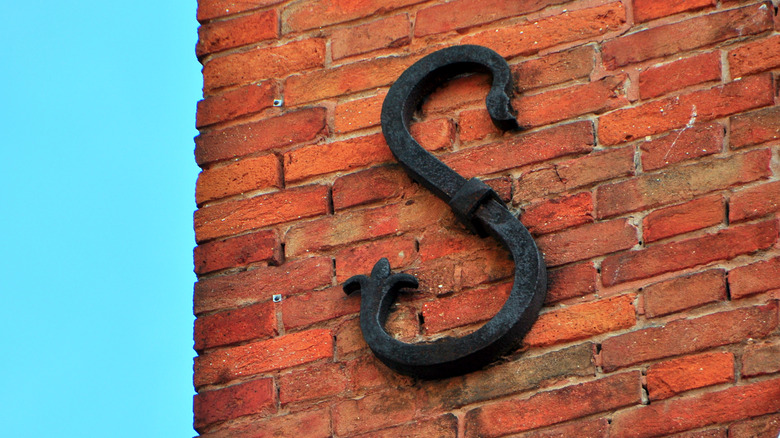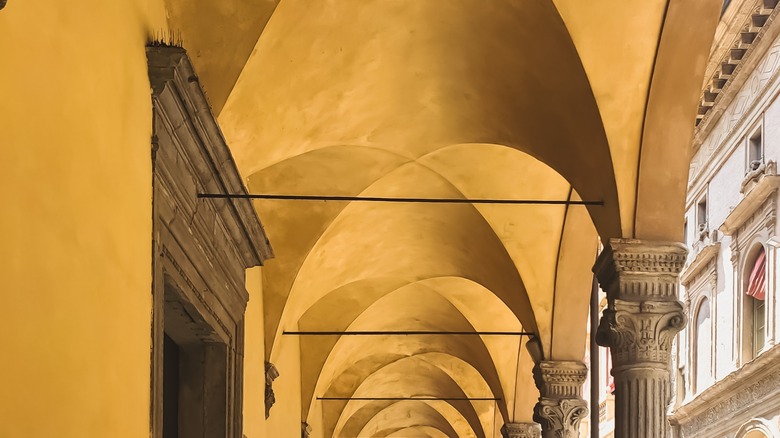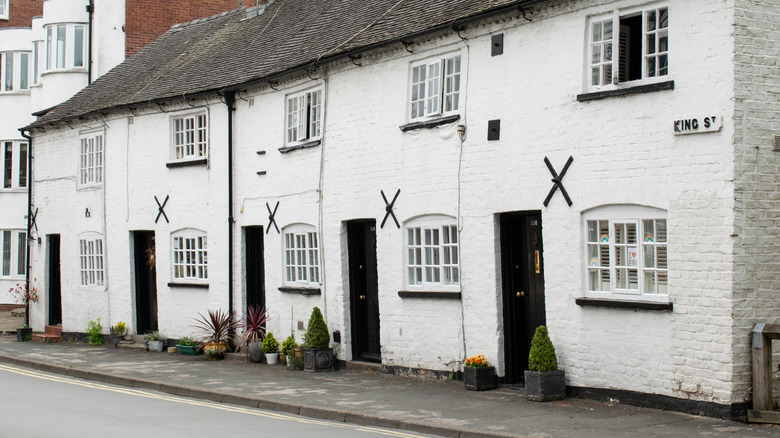What It Means To See Those Metal Symbols On Brick Houses
If you've ever taken a leisurely stroll through the historical side of town, you may have noticed some strange metal shapes on the sides of brick houses. At first, these metal pieces may seem like some oddly-hung décor or perhaps a family monogram that's just slightly out of place. To unknowing onlookers, they may even seem confusing or sinister. Could they be some sort of secret city code? Some historical neighborhood mystery that is yet to be explained?
Rest assured, these metal symbols are nothing unusual. In fact, they actually served a very important purpose for brick houses in their time. These metal fixtures are called pattress plates or anchor plates, and they can be shaped like letters (especially S's and X's), symbols, stars, and other designs. They're commonly found on the oldest homes in America and were used to offer significant protection from natural disasters.
Pattress plates connect to the ends of tie rods, which run through a building's main structure. They are meant to keep the brick walls of buildings from bowing outward under pressure. Here's the fascinating history of tie rods and pattress plates, how they work, and how they've adapted to suit today's modern home.
An unshaken architectural technique
While they have been used and adapted by people around the world, the method of using ties and pattress plates originally came from Greek and Roman architects, who used them to stabilize archways and tall ceilings. In America, these structural supports really gained traction after a natural disaster struck Charleston, South Carolina. In 1886, Charleston experienced a massive earthquake that was powerful enough to shake areas from New York City down to Louisiana. As a result, Charleston suffered significant damage to over 8,000 of the city's buildings. However, some brick buildings seemed miraculously untouched — or at least they remained much more intact than their neighbors. As they sifted through the rubble, architects and engineers discovered that many of the surviving buildings were built using ties and pattress plates, which gave them extra stability during the earthquake.
Ties and pattress plates work by anchoring the exterior brick walls closely against interior elements and support beams. A tie runs through the structure of a house and the plates anchor either end and diffuse pressure across the bricks. If a natural disaster like a hurricane, tornado, or earthquake shakes the building, the brick won't buckle or topple away from the main structure. One way to think of this is like a deli sandwich. The pastrami filling is your main structure, the bread is your brick walls, and the long toothpick that runs through the middle of your sandwich works like a tie rod!
Ties and pattress plates today
Ties and pattress plates were common in Europe and along the east coast of the United States in the 19th and early 20th century. These simple but mighty structures have ensured that many of the historical brick buildings in these areas are still standing today. However, few (if any) homes built today still include traditional tie rod systems. Instead, some use more modern snap ties or epoxy anchors. Traditional-style metal tie rods can also be seen today supporting bridges and other massive steel structures.
If you're the lucky owner of one of these historical homes, you may love or hate the look of your exterior pattress plates. Either way, you can rest assured that they add strength and value to the home itself, especially if you live in an area prone to earthquakes and other natural disasters. Metal pattress plates can also often be refinished and painted to suit your home's style. Some pattress plates may also be replaceable with more ornamental designs, so you can pick a plate that blends well with your home's exterior while still offering some support. However, it's always a good idea to talk to a knowledgeable home inspector or building engineer before tampering with your home's structural features. Additionally, while tie rods and pattress plates can't easily be added to existing structures, there are other ways to retrofit an old house against earthquakes.


